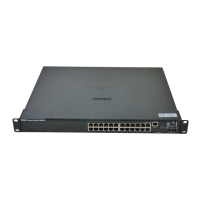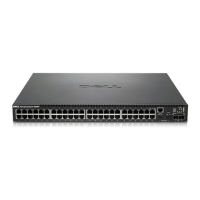30 Dell PowerConnect 55xx Systems User Guide
FILE LOCATION: C:\Users\gina\Desktop\Checkout_new\Maintenance Projects\Dell
Contax\CxUGFeatures.fm
DELL CONFIDENTIAL – PRELIMINARY 9/11/12 - FOR PROOF ONLY
Due to the complexity of 802.1x setup and configuration, many mistakes can
be made that might cause loss of connectivity or incorrect behavior. The
802.1x Monitor mode enables applying 802.1x functionality to the switch,
with all necessary RADIUS and/or domain servers active, without actually
taking any action that may cause unexpected behavior. In this way, the user
can test the 802.1x setup before actually applying it.
For more information, see "RADIUS" on page 291.
SSH
Secure Shell (SSH) is a protocol that provides a secure, remote connection to
a device. SSH version 2 is currently supported. The SSH server feature
enables an SSH client to establish a secure, encrypted connection with a
device. This connection provides functionality that is similar to an inbound
telnet connection. SSH uses RSA and DSA Public Key cryptography for
device connections and authentication.
For more information, see "Security Management and Password
Configuration" on page 75.
TACACS+
TACACS+ provides centralized security for validation of users accessing the
device. TACACS+ provides a centralized, user management system, while
still retaining consistency with RADIUS and other authentication processes.
For more information, see "TACACS+" on page 282.
Password Management
Password management provides increased network security and improved
password control. Passwords for SSH, Telnet, HTTP, HTTPS, and SNMP
access are assigned security features.
For more information, see "Password Management" on page 286.
The switch provides the ability to demand strong passwords, meaning that
they must contain both upper and lower-case letters, numbers, and
punctuation marks.
For more information, see "Password Management" on page 286.

